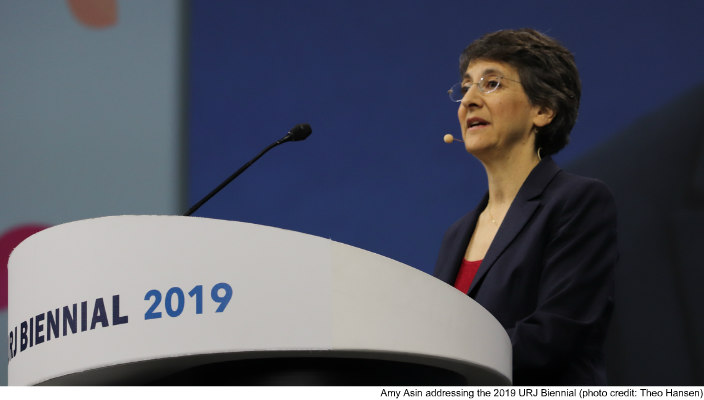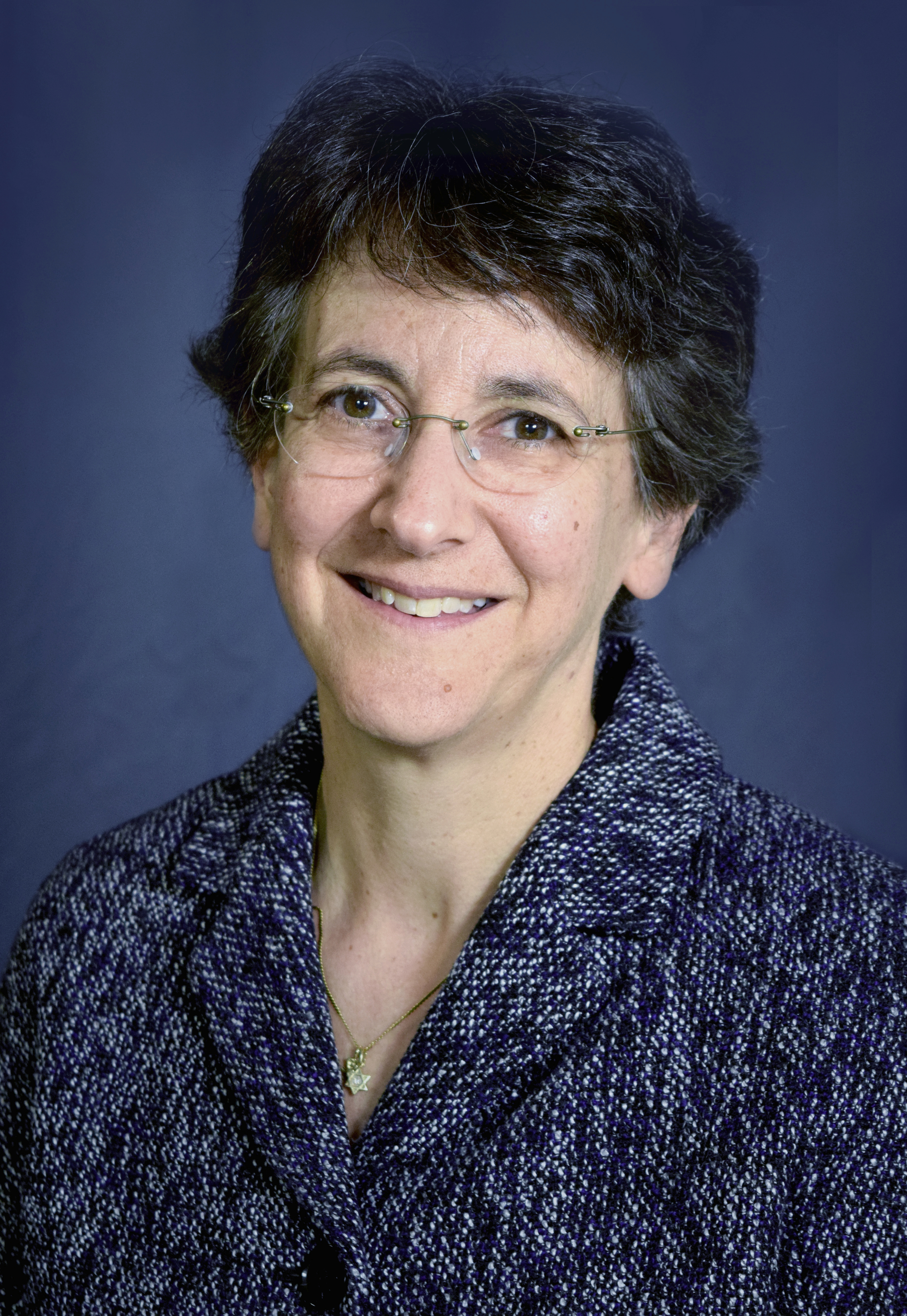
Editor's note: The text that follows was presented before a live audience at the 2019 URJ Biennial on Thursday, Dec. 12.
One of my favorite cartoons addresses our comfort level with change.
In the first frame, a speaker standing at the front of a room, like me, asks people sitting in chairs, like you – “Who wants change?” Every hand is raised. In the second frame, the person at the front asks, “Who wants to change?” and not a single hand is raised. In the third frame, the speaker asks, “Who wants to lead the change?” and the room empties out.
Sound like a familiar feeling?
I’m here to tell you that we – as a Movement, as leaders of Reform congregational life in North America – are going to have to want change, want to change, and all of us will need to lead that change.
The Union for Reform Judaism (URJ) is deeply committed to the success of our congregations. It is the foundation of who we are. It is what we are called to do. You have been asking us how to get more members to join and be engaged, and how to grow financial support. I’m here to tell you: The same old ways won’t work. But change can.
There are hundreds of thousands of Jews and Jewish-adjacent people out there who have not yet connected to a Jewish community. Like us, they worry about their kids, their aging parents, their mortality, and their jobs. They worry about polarization, instability, finances, and more. They yearn for safety, comfort, community, and opportunities to make a difference. And they want meaning, joy, and purpose. They can find all of this in our buildings and in the richness of our Jewish texts. But their first instinct is not to seek answers at Torah study or to show up on Friday night. While it’s true that we have something to offer the people who have yet to connect, there is a major disconnect between the ways in which we offer it and what they are looking for, and it’s our job – if we want strong congregations – to work with them to find a new way.
This requires all of us to change, and more importantly, it requires you to be leaders of change in your congregations.
Let me share with you some trends that are driving this need for change.
First, there are a lot more choices in our lives and most of the newer ones are easy to access. Remember when there were only four TV channels? Remember when you had to go to a movie theater or there was only the choice between Hulu and Netflix? This same variety exists in Jewish life. We can access Jewish content in so many different ways, and many that don’t require us to get in a car.
Second, the Jewish community is dramatically more diverse than we had thought. According to the Jews of Color Field Building Initiative, we have undercounted the population of Jews of Color by almost one million people. One out of every 7-8 Jews is a person of color instead of the previously believed one out of every 30-40. We also have a larger LGBTQIA+ population, and 72 percent of non-Orthodox marriages are between someone who identifies as a Jew and someone who doesn’t but may be readily embracing being Jewish-adjacent. Many of our congregations do not reflect this diversity because we haven’t yet been open to the change we need to make in order for people who do not look or act like us to feel at home.
And, we are marrying less, having fewer children, and having them later. If you are waiting for couples whose oldest child is in third grade to join so that they can send kids to religious school, you are waiting even longer than in the past and encountering people who are much more settled in their lives. Even if they connect, they will not be as predisposed to making the congregation central as those at the same life stage did a generation ago.
Finally, people who are part of our congregational community are living longer, so our congregations are aging.
These and other societal changes come together to create an interesting challenge.
For the first time in human history we potentially have five generations of active adults in our congregations at the same time. This wide age span can be a strength. But the challenge is that these generations want different things. In most of our congregations and our Movement, most of the power and most of the financial resources are concentrated in the two oldest generations, who are more heterosexual, more in-married, more Ashkenazi and white, and wealthier than the youngest two. The youngest are eager for a Judaism that speaks to their experience of the world and delivered in new ways that work for them. The older generations often want to keep things the way are, asking why the younger generations won’t simply accept it that way.
****
I want to introduce you to two people who, despite these trends, have managed to connect to congregational life. Please welcome Sara Knizhnik and Joey Noble.
Amy Asin: Sara, your husband is from the Former Soviet Union and connected to his Jewish identity but not the religion itself, and you are Jewish-adjacent, having grown up in a Christian family. You connected to Congregation Or Shalom in Vernon Hills, IL, through the March for Our Lives after the Parkland massacre, but that connection wasn’t random. How did you connect?
Sara Knizhnik: We had sent our children to the preschool at Or Shalom but weren’t ready to make the commitment to join the congregation and enroll them in religious school for bar mitzvah. There wasn’t another alternative available, so we disconnected.
I’m a community organizer working in gun violence prevention, so when the tragedy happened in Parkland, it hit very close to home for me. I was personally deeply in need of spiritual support. On the morning of the March for Our Lives I was invited by some fellow organizers to make a poster before a service at Or Shalom.
When I walked in, many of my friends from the gun violence prevention movement were there – they were members of Or Shalom. I felt immediately at home, even at the Shabbat service, which was very accessible. We then went as a congregation to the march. I’m told that many members who weren’t regulars were there that day.
Mostly, I was so inspired that this congregation had found a way to connect its deeply held values, expressed through the prayers into action.
My husband and I are still not quite ready to join a congregation. I work most weekends, so time is really short. But when we are ready, it will definitely be a Reform Jewish home and it will be Or Shalom.
Amy Asin: Joey, you connected through a more typical path – religious school and your bar mitzvah. But your bar mitzvah was not typical. You were pretty resistant and were thinking of giving up on the whole thing. There wasn’t a lot of meaning in it for you. And you were starting to really get excited about music. Then one day, when almost all seemed lost, you found a way to combine your passion with your obligation. Can you tell us your story?
Joey Noble: Yes, I was about to drop out of bar mitzvah prep, but Cantor Goldstein [from North Shore Congregation Israel in Glencoe, IL] asked me what was important to me. I pointed to his guitar and said I played. We started to play together, and he came up with a way for me to combine my guitar playing with my bar mitzvah prep. I actually helped lead the music of the service that morning. Once I was allowed to bring my love of guitar to my bar mitzvah, the rest of the prep didn’t seem so difficult. I was inspired.
Amy Asin: And you’re still playing on Shabbat at North Shore?
Joey Noble: Yes, I’m in college, and on Friday nights I drive in from school – about an hour to North Shore – and play in their worship band called Selah. There are a lot of people like me in the band – people who you wouldn’t normally see at services but who can connect through music.
Amy Asin: As I return the podium, can you play something for us? I hear you have something special prepared.
[Joey plays a song.]
Amy Asin: Thank you, Sara and Joey.
[Joey and Sara exit.]
****
Despite the trends, Sara and Joey have connected. Let’s examine how. Many congregational leaders are responding to today’s challenges by trying to change. They differ in the amount and type of change that they are seeking.
Some congregations will respond to challenges of today by trying to improve. Improver congregations keep the same goals and assumptions and work to change their methods.
They like things the way they are but wish more people would attend and pay. They are willing to tweak around the edges – even making some changes that feel big to them – but don’t actually seek to achieve much different results except trying to get more people to do the same thing. They don’t want to upset the power base of existing members – the words “people are complaining” or “people are saying” are mentioned a lot and given a lot of weight.
Because of this resistance to change, an improver congregation rarely stops a program. This keeps them from freeing up resources to do new things. A lot of the conversations in these congregations focus on budget at expense of mission and adherence to policy over risk-taking, both of which make bigger change harder to achieve.
Improving is important. Raising the bar toward excellence in how we execute shouldn’t be taken lightly, but it is not enough to thrive – or maybe even survive – going forward. If you are a leader in an improver congregation, you need ask your leadership partners to step up and consider moving to the next stop along the change continuum to be a transformer congregation.
Both of the congregations Sara and Joey are connected to are congregations experimenting with transformation. Transformer congregations shift assumptions and change goals to make deeper change than Improver congregations.
These congregations see the challenge not as filling seats in their existing program but as helping more people use the tools of Reform Judaism to live lives of wholeness, justice, and compassion.
Transformers consider people who aren’t quite in the door in their decision-making, and are willing to stop doing some things, even if it means that they have to spend time helping people adjust to transition and loss. And they collaborate a lot more, not expecting that the answers to their challenges are only found within the bounds of their organization. Ultimately, they spend more time speaking about mission and experimentation than budget.
Some of you have already done experiments like the ones that Sara’s and Joey’s congregations have done. If we are going to thrive as a Movement and as individual communities, the vast majority of our congregations need to be experimenting more, becoming transformers in more areas of congregational life, and you need to be willing to lead this change.
What do leaders in transforming congregations do? First, they start with the lives of participants rather than the needs of the institution or the programs that they are trying to fill. A yearning for opportunities to make the world a better place, a passion for music.
As Rabbi Ari Margolis from Or Shalom said, “We ask, How does being a part of this congregation or this program make someone’s life better? If we do not have an answer to that question, we shouldn’t be doing it.”
Leaders of transformation empower people who are ready to deliver rather than only thinking of the leaders who are in positions of power.
In Sara’s case, teens in the congregation organized to make the march and service happen – not the worship committee that may have felt the need to approve a change in Shabbat observance, although they were consulted; not the social justice committee that didn’t have the march in their plans, although they may have supported the idea; not even the clergy, who were willing to make room for others to have a voice and then work with them to turn their passion into action.
Transformational leaders are willing to take a risk to serve people outside of the mainstream – to build for people who are not comfortable with the current system.
Joey had not bought into the bar mitzvah process but is still engaged as a college student. In Sara’s case, the leadership worked in relationship with congregants who opposed participation in the march and attracted people who normally didn’t participate, members and non-members alike. By taking these risks and making these changes, both congregations sought to build for the congregation of the future, which helped to strengthen the congregation of today.
An area where we have seen a lot of transformation and could support more is Jewish education. Many of our educators and their sacred partners are challenging us to think beyond improvements – such as rewriting curriculum – towards transformational change that rewrites goals – for example, moving from a schooling model that prizes knowledge acquisition to learning based on authentic Jewish experiences, or even learning that starts with children’s and families’ passions or big questions about life, leveraging the creativity of our tradition to address the personal and the communal challenges we all face.
We need more of you to step up to being leaders of transformational change.
There are some congregations that will take on even more. They will seek to disrupt. Disrupter congregations change methods and goals, and they are willing to put their assets at risk.
It’s really hard to disrupt yourself because it requires a willingness to change things even though they seem to be working. Disrupters completely redefine their delivery model – maybe selling their building, restructuring their staff, or cutting out large portions of their program in favor of others. They may risk their current core audience in order to attract a larger audience that is on the outside. A disrupter seeks to create great Jewish experiences grounded in the needs of potential participants rather than thinking only about being the best at the standard programmatic areas of congregational life. And finally, they are laser focused on mission, often saying the words, “We don’t do that, but we do this.”
Very few congregations will disrupt their entire congregation. But we need more of our congregations to begin disruptive experiments, and then we need them to share what they learn with the rest of the Movement.
Why talk so much about change?
Because the decision to stay the same is a decision to allow the synagogue model to fade away.
If you are an Improver and do not go beyond improving, you are most likely going to disappear. Your endowments, planned giving, or advantaged area demographics might slow the pace of that collapse, but unfortunately, it will happen.
Transformers have a very good chance of being strong going forward. You also will need endowments and planned giving because the funding model needs to change, and demographics can help.
The disrupters, we don’t know. Risks are high. Rewards might be as well. Total disruption will be rare. Disruptive experiments can take us to new places.
And let me be clear: No type of change will be successful if it is attempted by a single person without buy-in and deep, sacred partnership among leaders – lay, clergy, and professional.
My question to you is which congregation are you leading right now, and which do you want to become?
If you are an improver, how can you start doing transformational experiments?
If transformation is a habit in some parts of congregational life, how can you bring it to more?
And, if you are ready, where can you try something disruptive?
We at the URJ are ready to support your congregation as you work to move up the change continuum.
As an example, one of the most successful offerings we have for leaders of change is the Scheidt Seminar for Congregational Presidents and Presidents-Elect. I am thrilled to announce today that the Scheidt family has contributed an additional $1 million toward that program to help ensure that our congregational presidents are equipped to lead through the change our congregations require.
We also seek to leverage this network to work together for change, for you to share your experiments, successes, and failures – to collaborate among each other and with others in your communities. You will have chances throughout the rest of this Biennial and after to learn more and to commit to being a change agent.
So take a minute, and look inside. What are you willing to commit to in this moment? Do you want change? Are you willing to change? Are you willing to lead the change?
Together we will meet the sacred call to bring Jewish wisdom to those who seek it.
To learn more about types of change – read the article ”How Your Congregation Can Move Up the Change Continuum” by Amy Asin. You can also commit to being an agent of change in your congregation today.
Looking for more addresses from the URJ Biennial? Check out this roundup.
Related Posts

Setting Your Leaders Up For Success

Safety, Equity, and Accountability is the Path to a Thriving Jewish Community

